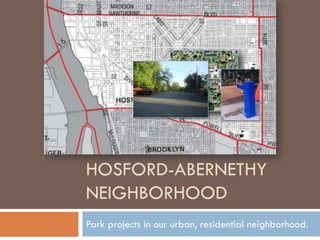
Hosford-Abernethy Presentation / Southeast Uplift Green Space Workshop
- 1. HOSFORD-ABERNETHY NEIGHBORHOOD Park projects in our urban, residential neighborhood.
- 2. HAND Neighborhood Projects Pocket Park Project – changing a street, SE 19th Ave. to a park or “Avalon Sanctuary” Establishingownership of street Coordinating with bureaus and agencies Creating relationships and funding resources Piccolo Park Drinking Fountain Fundraiser – advocating for basic resources & amenities. Establishing need – can it be done? Cost? Creating partnerships and coordinating with bureaus
- 3. Establishing Ownership of Empty Lots Division/Vision Green Street Project & 7 Corners Area study :: Projects took a closer look at lots and zoning along Division Street. Where were there unused spaces?
- 4. Could a dead-end street become something else? Began to investigate what it would take to change SE 19th Ave. into a park or open space – is it possible? Started dialogue with staff, neighbors and others.
- 5. Establishing Ownership of Empty Lots Remember: The first answer is not always accurate. If sources conflict, check and check again. Get clarity on which bureau “owns” it.
- 6. Researched the Land at 19th Ave. Confirmed it was not a “right of way” but owned “outright.” City bought lot in 1902 for $1 from estate of Mary Fox Tibbetts. “Avalon Street” renamed 19th in 1933.
- 7. Linear Park Permit Request PBOT’s only process for improving or changing a street. No proven track record. Need support from immediate land owners.
- 8. Making Use of Many Goals If there was neighbor support, could this project meet multiple objectives already in place? Started to explore resources already available.
- 9. Community Outreach / Feedback Began to foster relationships with Creative process – What are the… neighbors and businesses. Uses? Needs? Challenges?
- 10. Putting the Details Together Funding and Design Resources Building Support/ Event Outreach PBOT Application Street Fair(s) Funding Sources? PARKing Day
- 11. “What if?” & “Why not?” Approach Illustrating Possibilities: Utilizing Drawing on Resources already in resources in the community. motion – Division Streetscape.
- 12. Biggest Hurdle to Grant Funding Who “owns” the land? Who has the final say? You can’t apply to most grants if you don’t have “managerial” designation or permission.
- 13. Seeking Support – TKF Foundation Proposal Grant proposal for long term study on place-making and repair in an urban core.
- 14. Realizing Long Term Challenges Who is in charge of maintenance? Long term funding - City budget - SDC’s - Fundraisers Support and stewardship
- 15. Public-Private Partnerships for Basic Resources Establishing partnerships can help with something as simple as a drinking fountain. Continuing tradition of Piccolo Park, built after Mt. Hood Freeway Project was defeated.
- 16. Piccolo Park Drinking Fountain How do you get a basic amenity installed? Biggest hurdle is funding – who pays for it? SDCs? City? Coordinating with the right bureau – in this case Portland Parks and Recreation.
- 17. “What does it take to do this?” Actual cost - $7,000 for complete installation Establishing neighborhood support
- 18. Building on Community Resources Develop a Portland Parks Foundation Fiscal strategy and Sponsorship create partnerships Volunteer graphic design and project to add coordination credibility to your project. Business District – dine out nights, publicity, flat donations Immediate neighbors, “Friends of Piccolo Park” Including information in neighborhood and school newsletters.
- 19. Celebrating as a community once again Included key supporters in a dedication and celebration. Invited everyone to participate. All ages left with a sense of value and place.
- 20. What are the biggest challenges? Where we need clarification in working with the City on creating parks, gardens, open space in our neighborhoods.
- 21. Finding the Right Place to Start City Bureaus & Staff Who to talk to? Establishing Fiscal Support/Partnerships Create opportunities for neighbors to participate Utilize volunteer resources
- 22. Working with others on big questions System Development Charges How are funds allocated? How does a neighborhood apply? When to bank on your own and when to ask for partnership support. Explore working as a coalition and Park Bureau’s two-acre minimum park size. Does this policy work in denser or developing parts of our city?
- 23. Stay positive and believe in your project!